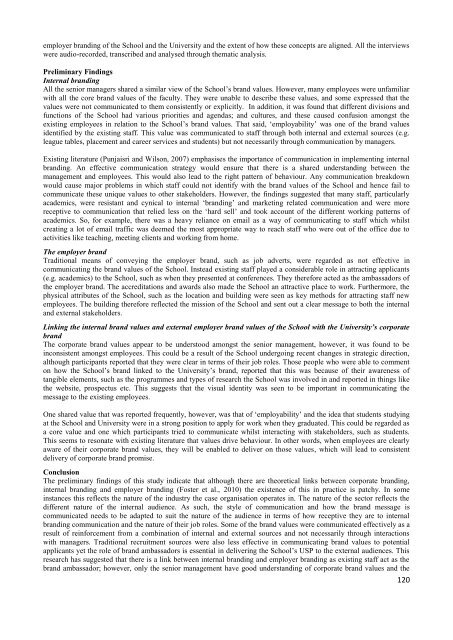Brand, Identity and Reputation: Exploring, Creating New Realities ...
Brand, Identity and Reputation: Exploring, Creating New Realities ...
Brand, Identity and Reputation: Exploring, Creating New Realities ...
Create successful ePaper yourself
Turn your PDF publications into a flip-book with our unique Google optimized e-Paper software.
employer br<strong>and</strong>ing of the School <strong>and</strong> the University <strong>and</strong> the extent of how these concepts are aligned. All the interviews<br />
were audio-recorded, transcribed <strong>and</strong> analysed through thematic analysis.<br />
Preliminary Findings<br />
Internal br<strong>and</strong>ing<br />
All the senior managers shared a similar view of the School‘s br<strong>and</strong> values. However, many employees were unfamiliar<br />
with all the core br<strong>and</strong> values of the faculty. They were unable to describe these values, <strong>and</strong> some expressed that the<br />
values were not communicated to them consistently or explicitly. In addition, it was found that different divisions <strong>and</strong><br />
functions of the School had various priorities <strong>and</strong> agendas; <strong>and</strong> cultures, <strong>and</strong> these caused confusion amongst the<br />
existing employees in relation to the School‘s br<strong>and</strong> values. That said, ‗employability‘ was one of the br<strong>and</strong> values<br />
identified by the existing staff. This value was communicated to staff through both internal <strong>and</strong> external sources (e.g.<br />
league tables, placement <strong>and</strong> career services <strong>and</strong> students) but not necessarily through communication by managers.<br />
Existing literature (Punjaisri <strong>and</strong> Wilson, 2007) emphasises the importance of communication in implementing internal<br />
br<strong>and</strong>ing. An effective communication strategy would ensure that there is a shared underst<strong>and</strong>ing between the<br />
management <strong>and</strong> employees. This would also lead to the right pattern of behaviour. Any communication breakdown<br />
would cause major problems in which staff could not identify with the br<strong>and</strong> values of the School <strong>and</strong> hence fail to<br />
communicate these unique values to other stakeholders. However, the findings suggested that many staff, particularly<br />
academics, were resistant <strong>and</strong> cynical to internal ‗br<strong>and</strong>ing‘ <strong>and</strong> marketing related communication <strong>and</strong> were more<br />
receptive to communication that relied less on the ‗hard sell‘ <strong>and</strong> took account of the different working patterns of<br />
academics. So, for example, there was a heavy reliance on email as a way of communicating to staff which whilst<br />
creating a lot of email traffic was deemed the most appropriate way to reach staff who were out of the office due to<br />
activities like teaching, meeting clients <strong>and</strong> working from home.<br />
The employer br<strong>and</strong><br />
Traditional means of conveying the employer br<strong>and</strong>, such as job adverts, were regarded as not effective in<br />
communicating the br<strong>and</strong> values of the School. Instead existing staff played a considerable role in attracting applicants<br />
(e.g. academics) to the School, such as when they presented at conferences. They therefore acted as the ambassadors of<br />
the employer br<strong>and</strong>. The accreditations <strong>and</strong> awards also made the School an attractive place to work. Furthermore, the<br />
physical attributes of the School, such as the location <strong>and</strong> building were seen as key methods for attracting staff new<br />
employees. The building therefore reflected the mission of the School <strong>and</strong> sent out a clear message to both the internal<br />
<strong>and</strong> external stakeholders.<br />
Linking the internal br<strong>and</strong> values <strong>and</strong> external employer br<strong>and</strong> values of the School with the University’s corporate<br />
br<strong>and</strong><br />
The corporate br<strong>and</strong> values appear to be understood amongst the senior management, however, it was found to be<br />
inconsistent amongst employees. This could be a result of the School undergoing recent changes in strategic direction,<br />
although participants reported that they were clear in terms of their job roles. Those people who were able to comment<br />
on how the School‘s br<strong>and</strong> linked to the University‘s br<strong>and</strong>, reported that this was because of their awareness of<br />
tangible elements, such as the programmes <strong>and</strong> types of research the School was involved in <strong>and</strong> reported in things like<br />
the website, prospectus etc. This suggests that the visual identity was seen to be important in communicating the<br />
message to the existing employees.<br />
One shared value that was reported frequently, however, was that of ‗employability‘ <strong>and</strong> the idea that students studying<br />
at the School <strong>and</strong> University were in a strong position to apply for work when they graduated. This could be regarded as<br />
a core value <strong>and</strong> one which participants tried to communicate whilst interacting with stakeholders, such as students.<br />
This seems to resonate with existing literature that values drive behaviour. In other words, when employees are clearly<br />
aware of their corporate br<strong>and</strong> values, they will be enabled to deliver on those values, which will lead to consistent<br />
delivery of corporate br<strong>and</strong> promise.<br />
Conclusion<br />
The preliminary findings of this study indicate that although there are theoretical links between corporate br<strong>and</strong>ing,<br />
internal br<strong>and</strong>ing <strong>and</strong> employer br<strong>and</strong>ing (Foster et al., 2010) the existence of this in practice is patchy. In some<br />
instances this reflects the nature of the industry the case organisation operates in. The nature of the sector reflects the<br />
different nature of the internal audience. As such, the style of communication <strong>and</strong> how the br<strong>and</strong> message is<br />
communicated needs to be adapted to suit the nature of the audience in terms of how receptive they are to internal<br />
br<strong>and</strong>ing communication <strong>and</strong> the nature of their job roles. Some of the br<strong>and</strong> values were communicated effectively as a<br />
result of reinforcement from a combination of internal <strong>and</strong> external sources <strong>and</strong> not necessarily through interactions<br />
with managers. Traditional recruitment sources were also less effective in communicating br<strong>and</strong> values to potential<br />
applicants yet the role of br<strong>and</strong> ambassadors is essential in delivering the School‘s USP to the external audiences. This<br />
research has suggested that there is a link between internal br<strong>and</strong>ing <strong>and</strong> employer br<strong>and</strong>ing as existing staff act as the<br />
br<strong>and</strong> ambassador; however, only the senior management have good underst<strong>and</strong>ing of corporate br<strong>and</strong> values <strong>and</strong> the<br />
120
















